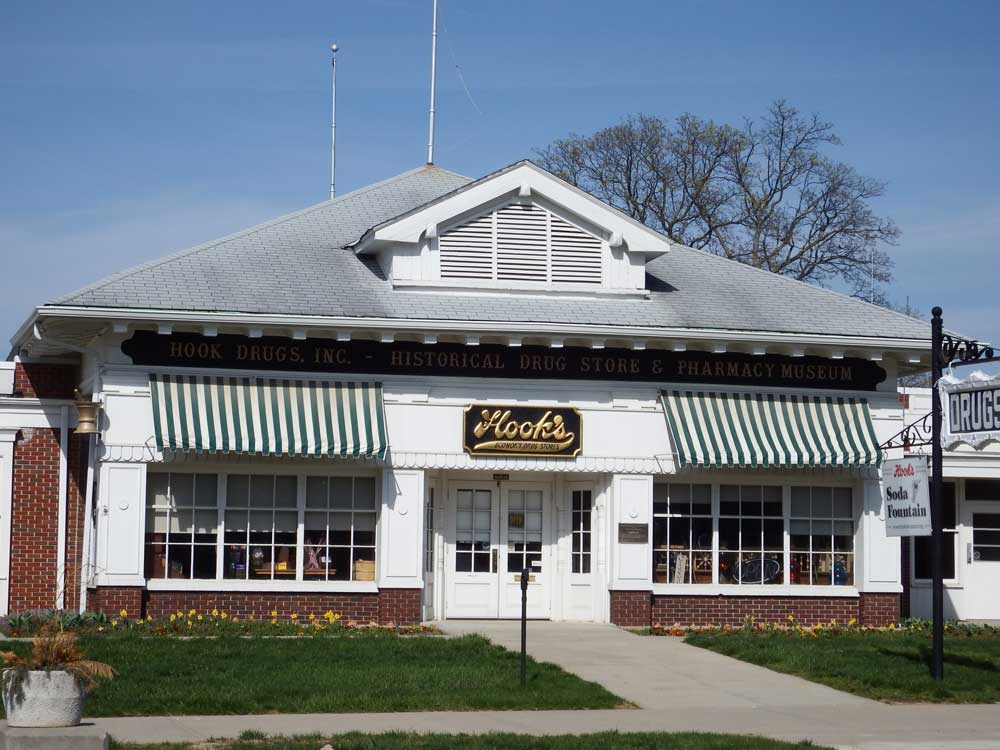
In 1965, Indiana’s Governor Roger Branigin challenged leaders of the state’s leading businesses to create special exhibits and events to celebrate 150 years of statehood (The Sesquicentennial), during the 1966 State Fair.
August (Bud) Hook, Chairman of locally based Hook’s Drugstore chain, decided to participate in the Sesquicentennial celebration by creating an exhibit honoring his company. Hook’s was started 1900 by John Hook, Bud’s father, with a single store, but had since grown into a large chain of over 100 locations. Rather than simply set up a display in one of the State Fair exhibit halls, Hook would uniquely recreate a complete and authentic late 1800’s historic drugstore he called “A Gift to the State of Indiana”.
Hook first convinced the Fairgrounds to allow the use of a small and underutilized building on the grounds for the Museum exhibit. The so called “Better Babies Building” was originally constructed and used for public health education, to counsel new mothers in all matters of maternal and early childhood health. The Better Babies program ended in the 1940’s, and the building had served various purposes since that time including but not limited to headquarters for the State Police during the Fair, a First Aid station, and vendor offices.
In order to create the authentic look and feel of a late 1800’s drugstore, not only would Hook need to procure hundreds of pharmacy antiques, but he would also have to find a complete interior set of historic drugstore cabinets to display them in, not an easy task.
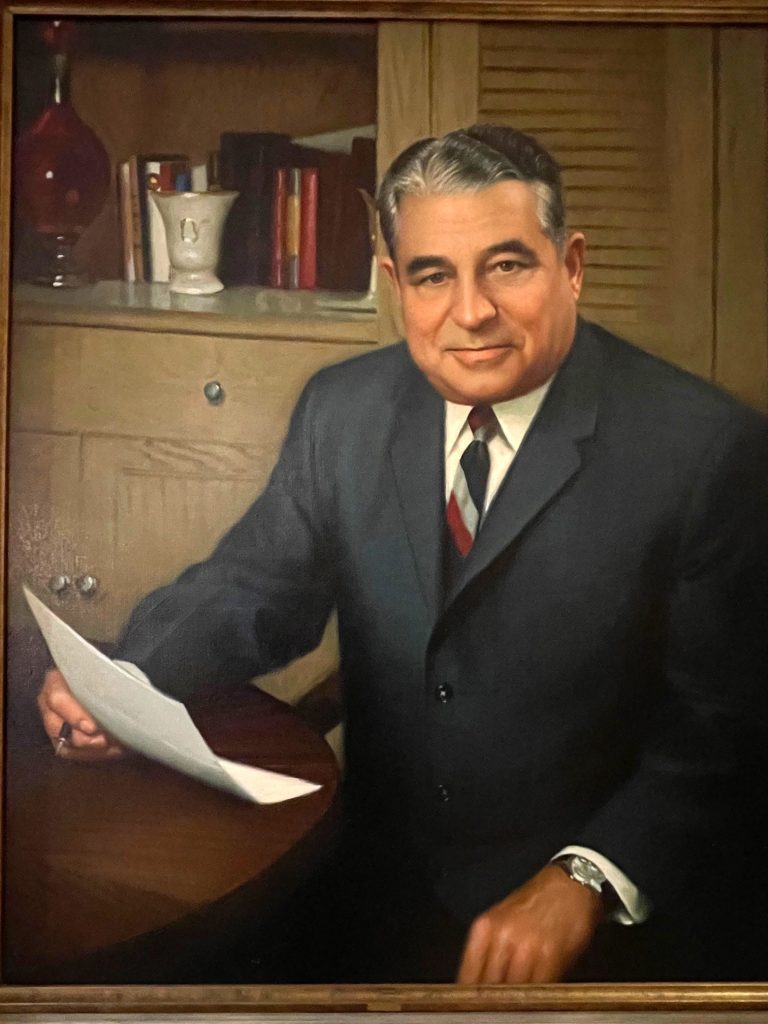
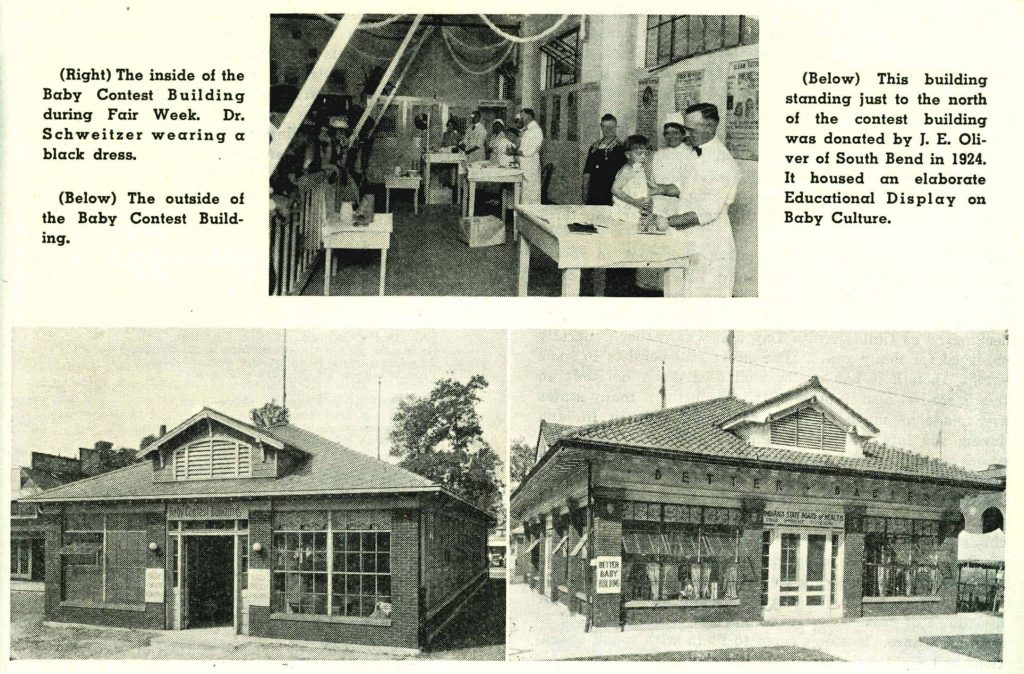
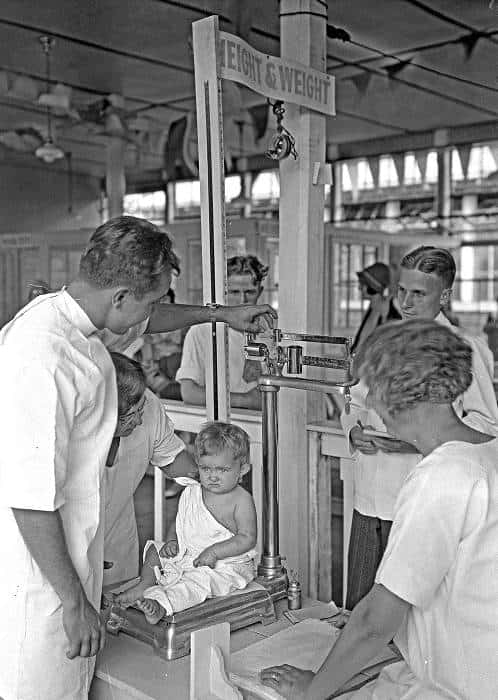
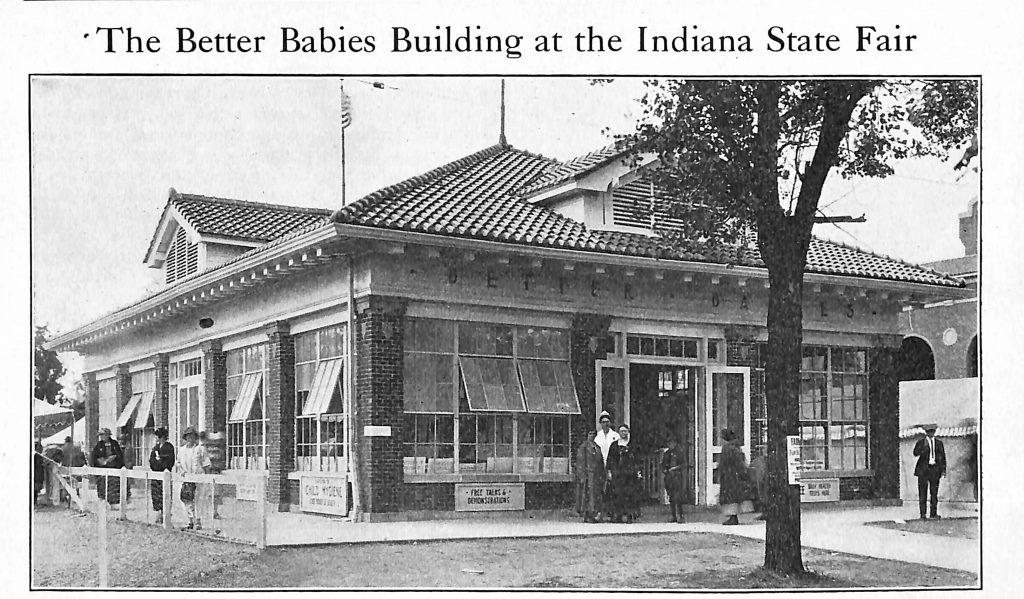
As luck would have it, there was a complete set of antique drugstore cabinets available in Cambridge City, Indiana. These cabinets were not only adequate for the exhibit, they were some of the finest pre-Civil War era drugstore cabinets anywhere in the country. Constructed in 1852, they were installed in the Sam H. Hoshour Drugstore in Cambridge City. Hoshour’s cabinets were made of walnut and ash wood, featuring the finest and fanciest details that money could buy, made by the best cabinet makers in Cincinnati. Samuel H. Hoshour was not only a druggist, but also practiced Medicine, and Law, in an office over the Drugstore, the sign to his upstairs office can be seen in this photo.
Remarkably, Hoshour’s interior cabinets survived over one hundred years with only minor changes, thanks to the careful stewardship of only two owners. Recently retired from daily use to make room for modern equipment, they were now stored in a barn. Rolla Grigsby, whose father purchased the drugstore from the Hoshour, had numerous offers to sell the antique cabinets once removed, but resisted. Hook’s offer to feature Grigsby’s complete set of interior cabinets as the centerpiece of recreated historic drugstore finally convinced him to sell.
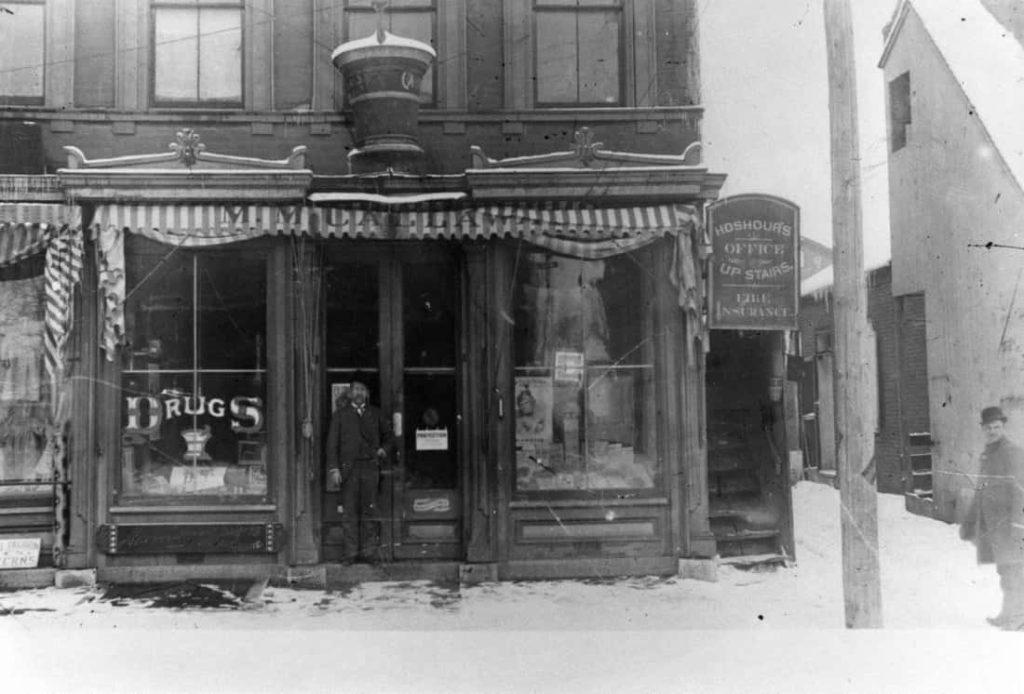
The former Better Babies building was modified somewhat to look more like a historic drugstore. A rough sawn wooden plank floor was added, and the interior was partitioned to create a space for the Cambridge City cabinets closely approximating the size of the space where they were originally installed. A wooden ceiling was also added, along with a mixture of authentic antique lighting, and other indirect lighting. To complete the look and feel of an old-time drugstore, a large baseburner was added to the center of the room, as would have been common in times before central heating. The baseburner is not antique per se, however, was made by a company that had continuously produced these heating units since the 1800’s, using all of the same materials and construction molds of the models manufactured in that timeframe. Even the windows of the firebox are authentically mineral mica which withstands heat better than glass.

For all of the antique medicines, bottles, signs, and equipment to furnish the drugstore and fill the cabinets, Hook turned to the several hundred pharmacists his company employed. He asked them to look in their basements, closets, and attics, for drugstore related antiques they would be willing to donate. The Pharmacists responded, excited to help create a legacy honoring their profession. Today, the largest number of beloved artifacts still stocking the Museum walls and shelves today, came from these generous donations in 1966.
When the Hook’s Historical Drugstore and Pharmacy Museum opened at the 1966 State Fair, it drew huge crowds and garnered rave reviews. Not only did the Museum have beautiful artifacts for visitors to see, it also functioned as a real store. Nostalgic candy, souvenirs, gifts, and even non-prescription medicines, tobacco products, and common drugstore sundries were available for purchase. Tobacco products were later discontinued, in tandem with State Fair policy that no longer allowed smoking or sale of tobacco products on the grounds. The concept of being a “real store” offering a diverse selection of products in addition to a museum continues to be a core part of our operation to the present day, and an important source of funding for the continuation of the Museum.
Winner of the Governor’s Prize for best corporate contribution to the Sesquicentennial, and generating a large amount of positive publicity, Bud Hook moved quickly to renegotiate what had originally been a 3-month lease for the building.
Building on the success and publicity from opening the Hook’s Drugstore Museum in 1966, Hook’s increased its role in the State Fair overall the following year. In 1967, Hook’s was the lead Sponsor for the entire Fair, the Fair programs featuring pictures of Bud Hook, the Museum, and Hook’s Drugstores together with description about the Museum and Hook’s business.
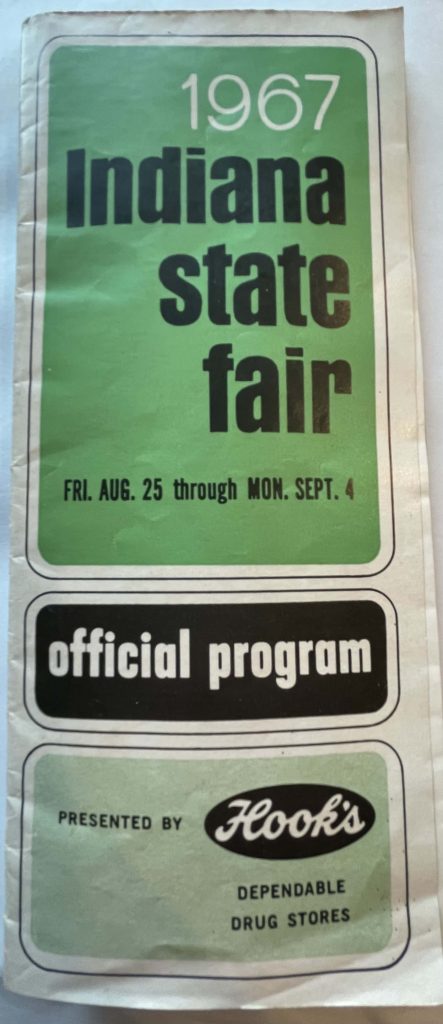
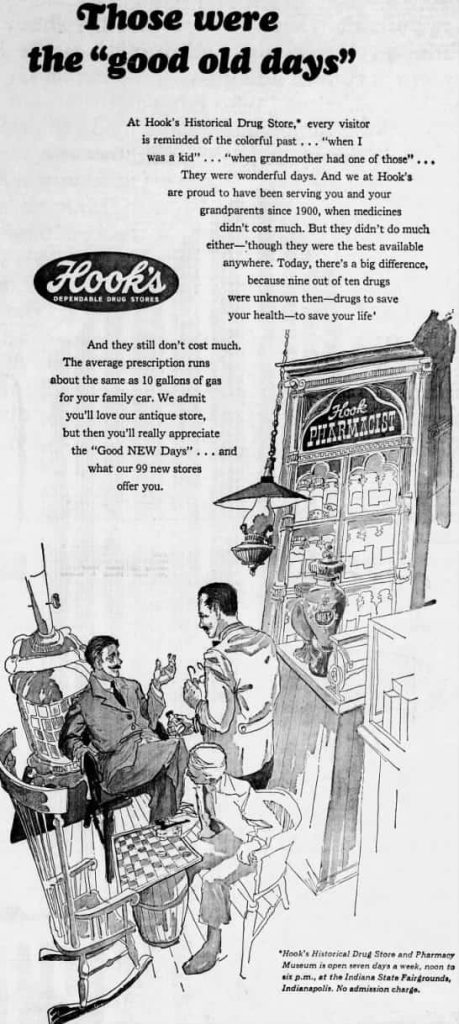
For the next 28 years, the Museum employed full-time staff, and opened daily except major holidays. Soda Fountain service was added in 1971. Hook’s frequently used the Museum as a backdrop for advertising, even filming television commercials promoting the hometown history of their business.
During the 1970’s, Hook’s added a second Historic Drugstore Museum and Soda Fountain for a few years in the popular tourist town of Nashville, Indiana.
They briefly contemplated opening even more. Ultimately the decision was to close the Nashville location, focusing only on the State Fair site.
During the late 1970’s, into the early 1980’s, large tents were erected on the North side of the of the building during the annual State Fair to serve Ice Cream Sodas in special “Hook’s collectible” glassware. Untold thousands of these sodas were sold for seventy five cents, and the glassware was a popular collectible for the public.
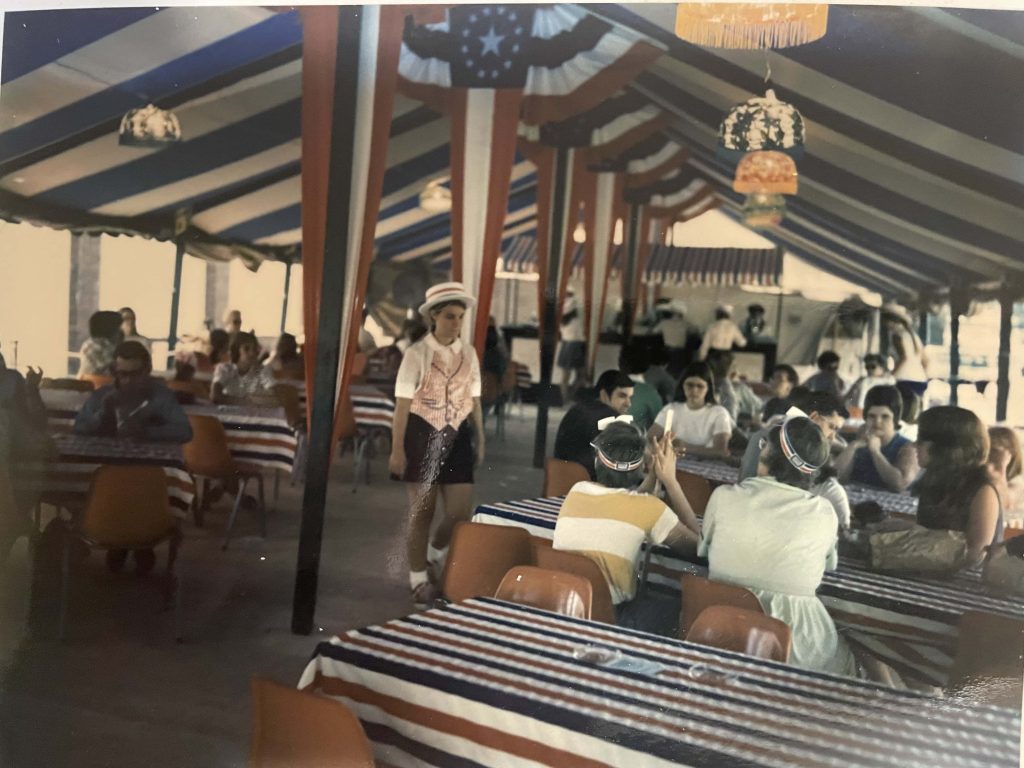
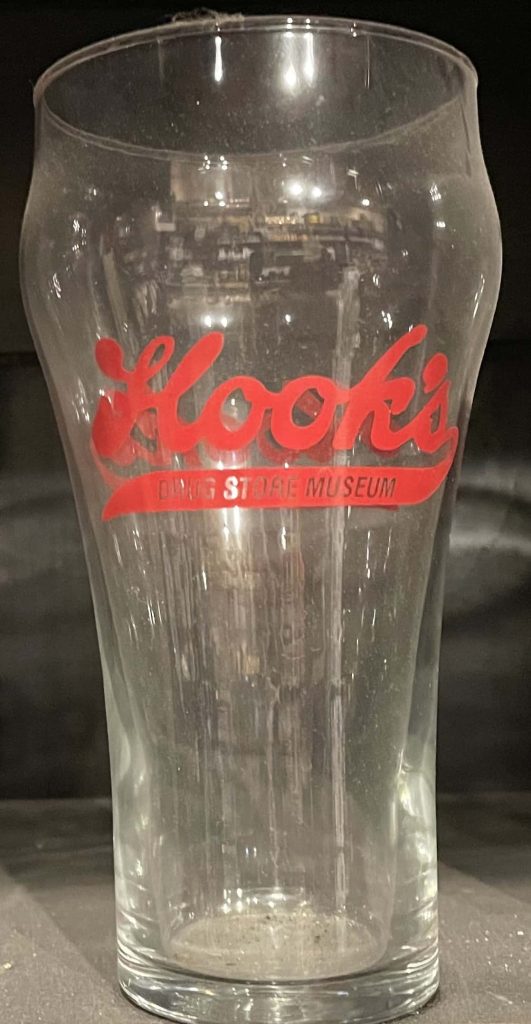
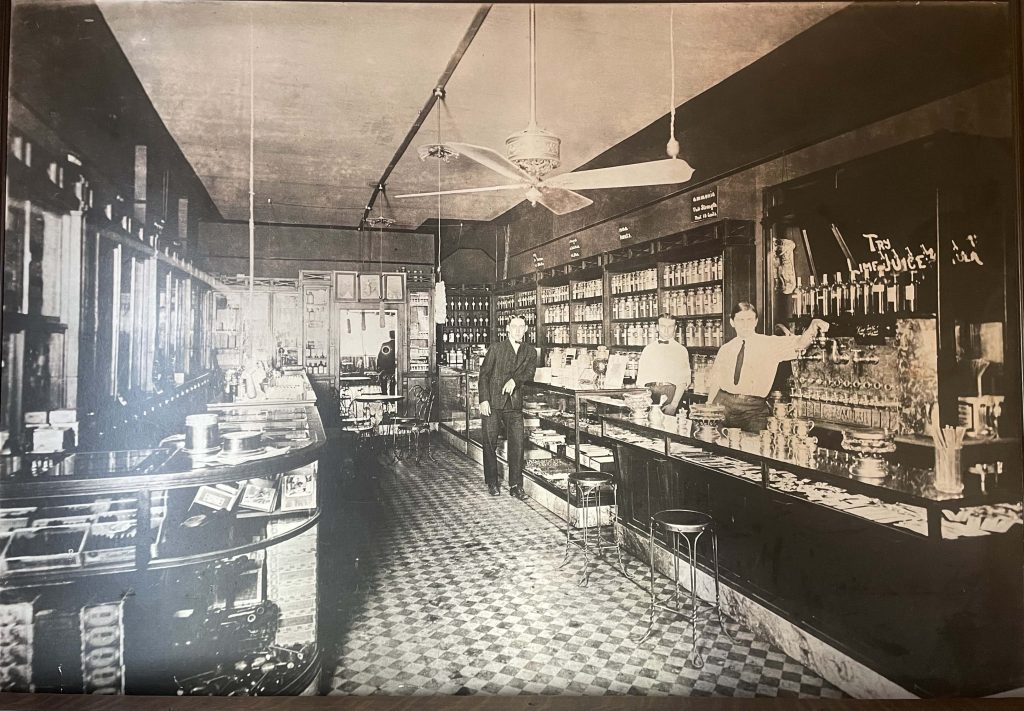
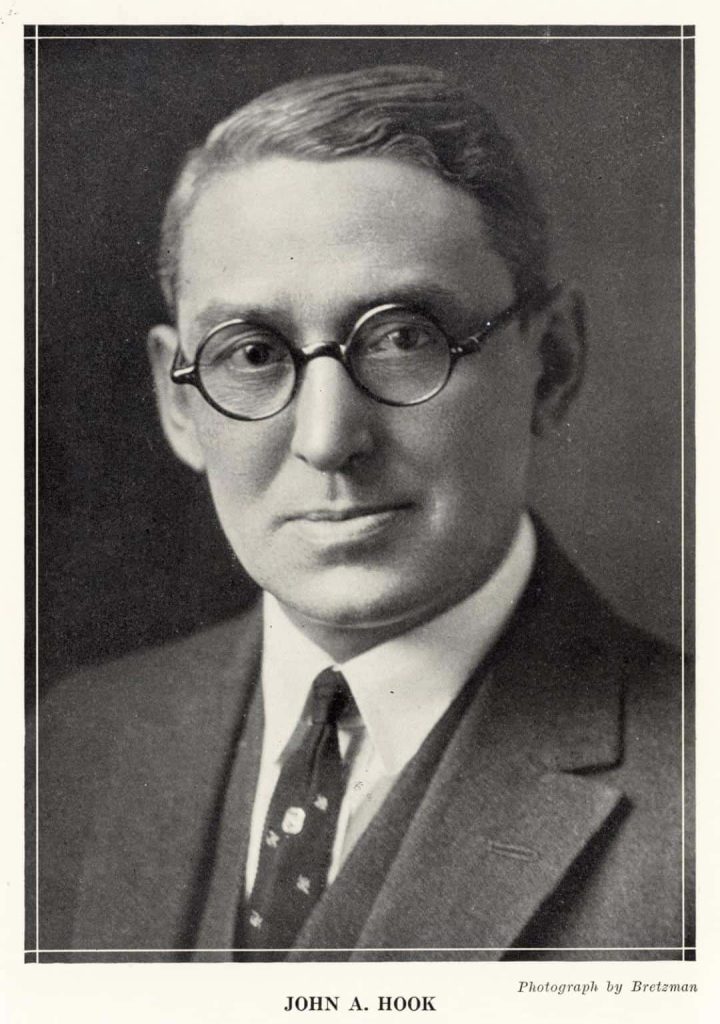

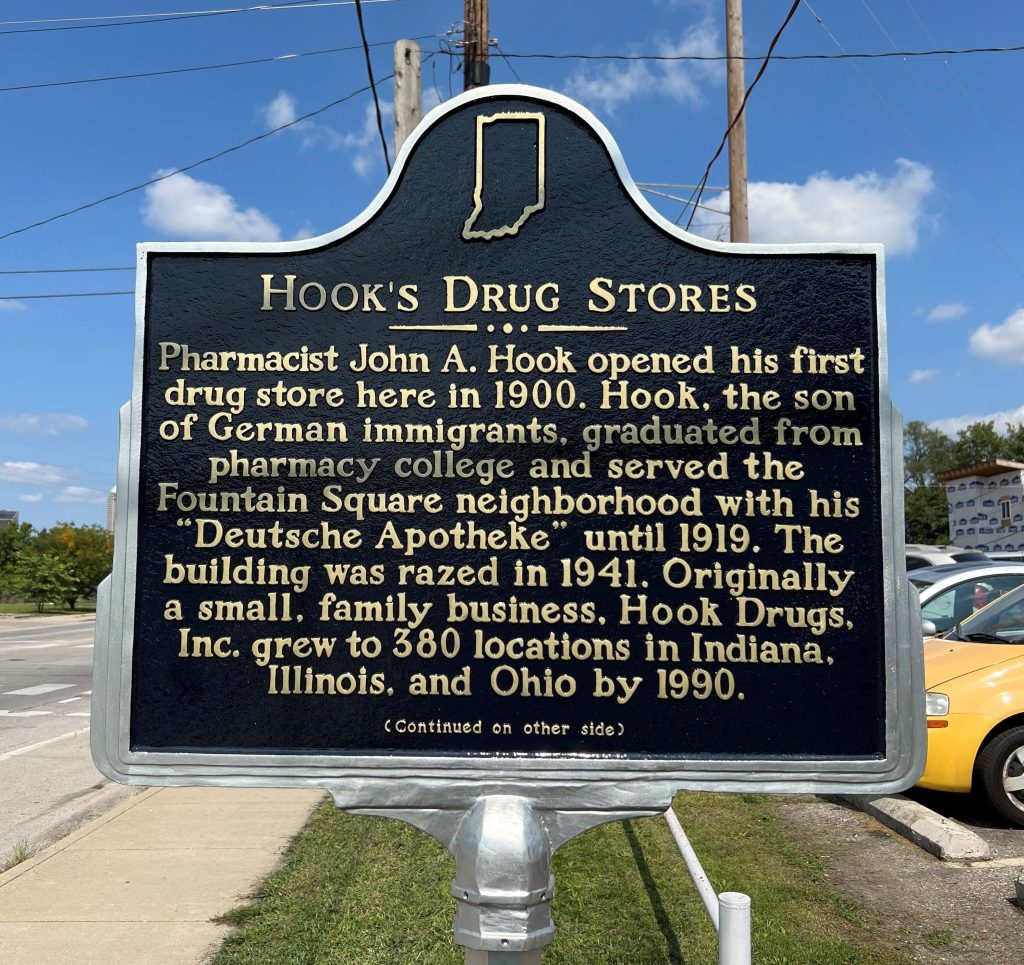
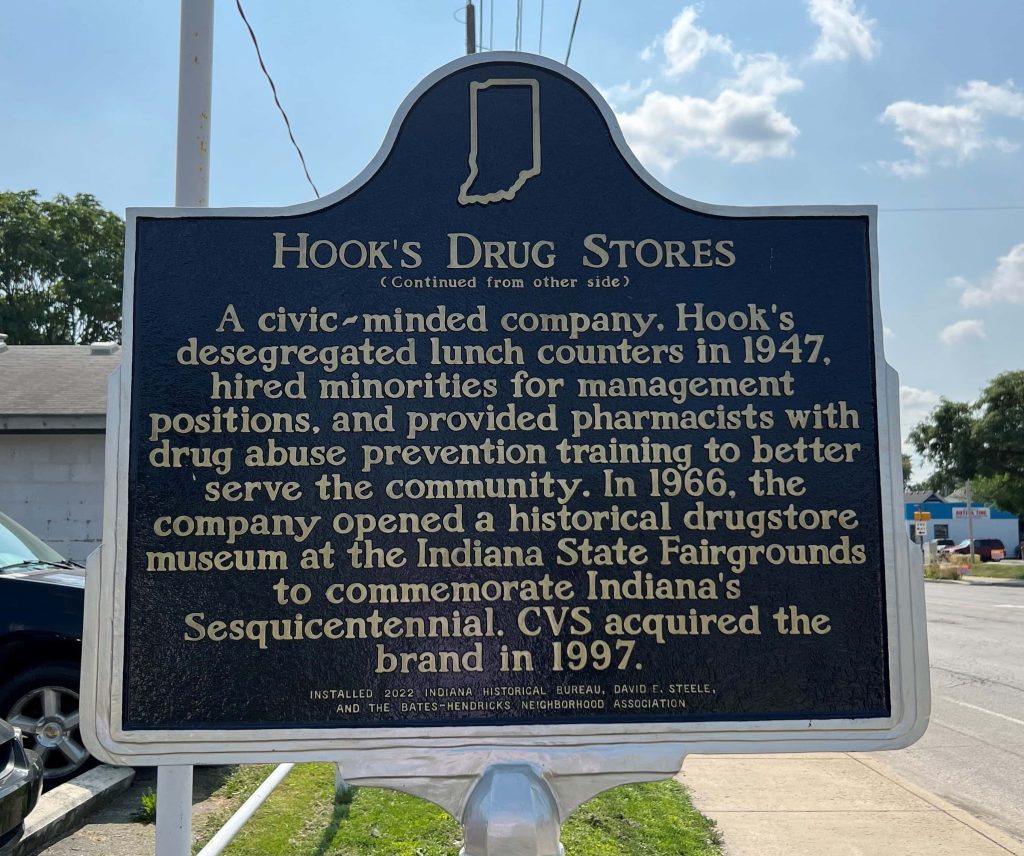
During the 1980’s Hook obtained permission to enlarge the building housing the Museum, to add two wings. One wing was dedicated to serving as a First Aid Station for Fairgoers, the other wing housed an office for Bud Hook, so he could spend more time at this beloved Museum during retirement years. Bud Hook passed away in 1992.
In 1987, Hook Drug inc. agreed to a friendly buyout from Kroger, to fend off hostile takeover by Rite Aid Drugstores. Hook’s retained its namesake stores, and most management. Following the Kroger purchase, the Museum continued as before.
In 1994, Kroger decided to divest their Pharmacy businesses to Revco Drug. With the sale to Revco, all former Hook’s Drugstores became “Revco” stores. Because the Museum was part of the Hook’s corporate property, ownership of the Museum passed to Revco.
Fortunately for the Museum, Revco quickly agreed to donate the Museum to the Hook’s Foundation, a private foundation originally started by Bud Hook to award scholarships to students pursuing pharmacy degrees. The Foundation subsequently created a separate new 501c3 non-profit organization focused solely on the Museum (Hook’s American Drugstore Museum). Hook’s American Drugstore Museum later changed their name to “Hook’s Discovery and Learning Center”.
Ownership of the Museum passed from Hook’s Discovery and Learning Center to the current organization in 2005. The Hook’s Museum is operated as a 501c3 public charity organization, created to insure the continuation of the Museum and its artifacts.
Today, the Museum continues to flourish, drawing well over 60,000 people during each State Fair. Over three million visitors have crossed the threshold since opening. Its not unusual to meet visitors who first experienced the Museum as children, now bringing their grandchildren. Gross sales from our soda fountain and candy/gift store operations have more than tripled since 2004. Local visitors who visit each year may not realize or appreciate that the familiar Museum in their backyard that serves up delicious chocolate sodas is now one of the most visited, and longest running institutions of its kind in America.
We look forward to a bright future at the Hook’s Museum, with opportunities to build on the past.

The Hook’s Drugstore Museum continues forward more than 55 years after its founding only because countless individuals over the years have given their time, talents, and financial support. It would be impossible to list everyone who has made a difference to insure continuation of this iconic Indiana destination.
There is one individual, however, who was remarkably involved with the Museum for over 50 years. James M. (Jim) Rogers along with Fred Edwards were the two Hook Drug Inc. employees charged with organizing and opening the Museum in 1966. Jim Rogers remained close to the Museum during the rest of his Hook Drug career, and in retirement, became a key leader and supporter through organizational transitions in 1987, 1994, 2003, including transfer to the current group in 2005. He continued as a trusted advisor and mentor until his passing in 2018.
Thank you, Jim Rogers!
August was a beer brewer, and chose Cincinnati for a home, because of the large German community and brewery businesses located there.
John Hook graduates from the Cincinnati College of Pharmacy, winning three gold medals for his academic excellence and achievements in materia medica, chemistry, and highest general academic average, a legitimate “wunderkind” of pharmacy.
John A Hook purchases his first store, an existing “Deutsche Apotheke” (German Apothecary) in a 1,000 square foot building at 1101 S. East St. in Fountain Square. Today, a State Historic marker identifies the site.
Hook opened a second downtown store at the corner of New Jersey & East Washington Streets. He also took on a partner – Edward F Roesch.
Over the next 38 years, Hook and Roesch work together as Hook’s continues to expand to new locations across the city.
Hook’s begins partnership with successful local architects Vonnegut (Father of Kurt Vonnegut), Bohn and Mueller to remodel existing drugstores Hook’s is acquiring, as well as designing new buildings for the growing business. The partnership between Hook’s and the architects endures for 20 years, with their innovative and modern designs helping to fuel business and growth for the drugstores.

Indiana Album, original photography, Bretzman Photography Studio, 1926
Bud Hook, now a pharmacist, also completes studies at Harvard Business school, and joins Hook Drug Inc. as a store Manager

East Strret looking north from Morris Street, 1935, Indianapolis Power and Light Co Distribution Systems Photographs. Photo courtesy of IUPUI University Library, loaned by Dee Dee Davis.
Hook’s business continues to expand and grow despite the depression.
John A. Hook dies. Ed Roesch (John’s partner since 1908) becomes president.
Hook’s Drugs, with approximately 50 stores throughout Indiana, celebrates its Golden Jubilee in with a grand opening of its store at 38th and Meridian Streets
Edward F Roesch dies, and Bud Hook takes over as president, Edward F. J. Roesch (son of Edward F. Roesch) is vice president. As President, Bud Hook, Purdue University athlete and pharmacy graduate will guide Hook’s Drugs through into a “Golden Era” of expansion and success
Bud Hook serves on a committee modeled after California’s Chamber of Commerce for Employment Opportunity, one of the committees’ goals being maximum employment opportunities for minorities.
Hook Drug Inc. plans to participate in the State Sesquicentennial celebration by opening a special re-created 19th century drugstore museum on the Indiana Fairgrounds. Antique cabinets are acquired in Cambridge City, Indiana from the Grigsby family for the primary display. Jim Rogers and Fred Edwards, Hook Drug employees, were charged with collecting artifacts to display in the Museum. Hook Drug notified the many pharmacists working for Hook’s of their plan to open a museum about pharmacy and requested donations of artifacts. Through generous donations, and some selected purchases, the Museum was soon filled.
Hook Drug opens Hook’s Historical Drug Store and Pharmacy Museum for Indiana’s Sesquicentennial. Hook Drug President, Bud Hook, called it “A gift to the people of Indiana”. The recreated 19th century drugstore was very popular and drew large crowds during the 1966 Fair. Governor Branigan Honored Hook with the “Governors Prize” for best corporate contribution to the Sesquicentennial. Following the Fair, Hook quickly negotiated the original three-month lease with the Fairgrounds for a longer term. Mr. Edwards worked with Hook’s until retirement, then moved to Georgia, and continued working with antiques as a collector, dealer, and appraiser. Mr. Rogers remained active with the Museum following his retirement from Hook’s. He was an important advisor and mentor in preserving the Museum and its collections until his death in 2018.
Hook’s increases minority management to 10%, and promotes W. Howard Bell to store manager, the second Black manager for Hook’s. By 1972, Bell owned 4 drugstores.
Hook’s advertises protected packaging, developing a child-proof, lock-on cap and amber colored containers to protect medications from sunlight, available at no extra charge to customers. Hook’s also provided a “Poison Counter dose Chart” to help prevent serious injury or possible death in the event of accidental overdose.
Hook’s increases promotion of Black staff to corporate positions. Ray Crowe, who coached the famous 1955 Crispus Attucks State Championship Basketball Team joins Hook’s and becomes a store employment supervisor in the personnel department.
Hook’s provides a $40,000 grant to establish a statewide network of regional hospital emergency treatment centers to help provide information for emergency treatment from poisoning. The Indiana Poison Center has become a lasting legacy, today a fully staffed 24 hour non-profit organization serving a critical role in assisting medical professionals and the community when poisonings occur.
The Kroger Company acquires Hook’s Drugs in a friendly takeover to fend off a hostile takeover attempt by Rite Aid Drugstore chain.
Kroger divests its pharmacy business in a sale to Revco. The Hook’s name is removed from all stores as they are renamed “Revco”. Revco assumes ownership of the Hook’s Drugstore Museum, however, decides to donate it to Hook Drug Foundation. Hook’s Drugstore Museum continues, under Hook Drug Foundation.
Today there is one operating Hook’s Apothecary (in addition to the Hook’s Drugstore Museum), the Apothecary was started by two of Bud Hook’s grandchildren.
Permission was granted from CVS to use the name Hook’s Apothecary and the logo was designed by Jim Rogers to give it the Hook’s Drugs familiarity without being identical to the original branded logo. Hook’s Apothecary, located in Evansville, IN, became Indiana’s first compounding only pharmacy, opening in 1999 and continuing today.